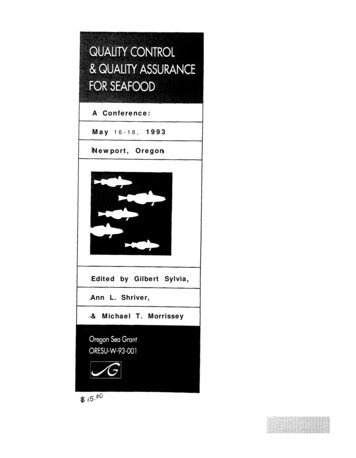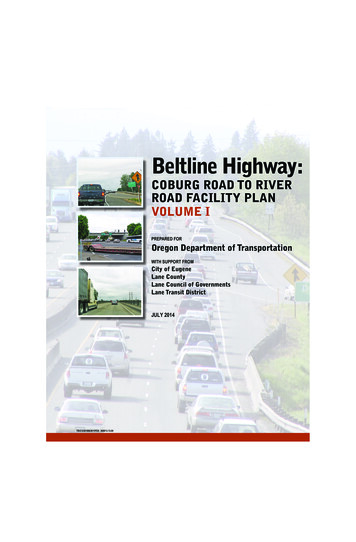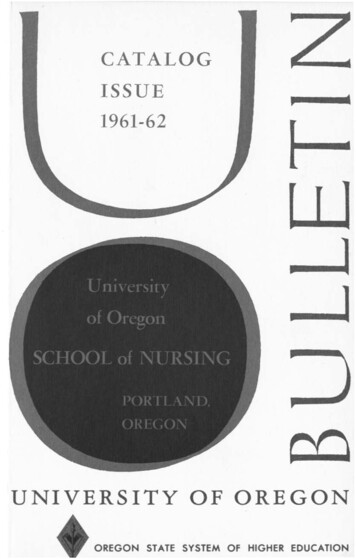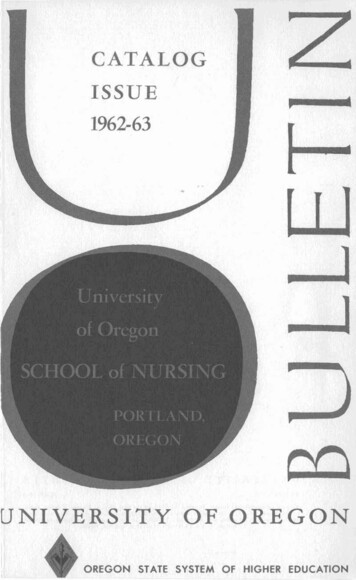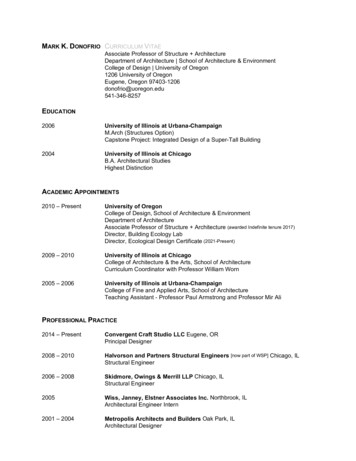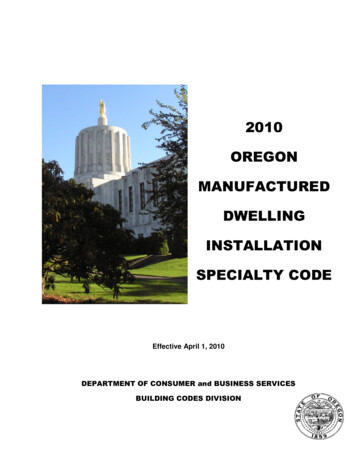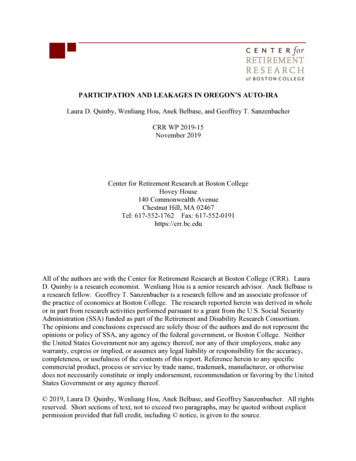
Transcription
PARTICIPATION AND LEAKAGES IN OREGON’S AUTO-IRALaura D. Quinby, Wenliang Hou, Anek Belbase, and Geoffrey T. SanzenbacherCRR WP 2019-15November 2019Center for Retirement Research at Boston CollegeHovey House140 Commonwealth AvenueChestnut Hill, MA 02467Tel: 617-552-1762 Fax: 617-552-0191https://crr.bc.eduAll of the authors are with the Center for Retirement Research at Boston College (CRR). LauraD. Quinby is a research economist. Wenliang Hou is a senior research advisor. Anek Belbase isa research fellow. Geoffrey T. Sanzenbacher is a research fellow and an associate professor ofthe practice of economics at Boston College. The research reported herein was derived in wholeor in part from research activities performed pursuant to a grant from the U.S. Social SecurityAdministration (SSA) funded as part of the Retirement and Disability Research Consortium.The opinions and conclusions expressed are solely those of the authors and do not represent theopinions or policy of SSA, any agency of the federal government, or Boston College. Neitherthe United States Government nor any agency thereof, nor any of their employees, make anywarranty, express or implied, or assumes any legal liability or responsibility for the accuracy,completeness, or usefulness of the contents of this report. Reference herein to any specificcommercial product, process or service by trade name, trademark, manufacturer, or otherwisedoes not necessarily constitute or imply endorsement, recommendation or favoring by the UnitedStates Government or any agency thereof. 2019, Laura D. Quinby, Wenliang Hou, Anek Belbase, and Geoffrey Sanzenbacher. All rightsreserved. Short sections of text, not to exceed two paragraphs, may be quoted without explicitpermission provided that full credit, including notice, is given to the source.
About the Center for Retirement ResearchThe Center for Retirement Research at Boston College, part of a consortium that includesparallel centers at the National Bureau of Economic Research, the University of Michigan, andthe University of Wisconsin-Madison, was established in 1998 through a grant from the U.S.Social Security Administration. The Center’s mission is to produce first-class research and forgea strong link between the academic community and decision-makers in the public and privatesectors around an issue of critical importance to the nation’s future. To achieve this mission, theCenter conducts a wide variety of research projects, transmits new findings to a broad audience,trains new scholars, and broadens access to valuable data sources.Center for Retirement Research at Boston CollegeHovey House140 Commonwealth AvenueChestnut Hill, MA 02467Tel: 617-552-1762 Fax: 617-552-0191https://crr.bc.eduAffiliated Institutions:The Brookings InstitutionMathematica – Center for Studying Disability PolicySyracuse UniversityUrban Institute
AbstractAbout half of private sector workers in the United States do not participate in anemployer-sponsored retirement plan at their current job. To fill the gap, a number of stategovernments around the country have recently launched initiatives to enroll their uncoveredworkers in Individual Retirement Accounts (IRAs). This paper reports on the experience ofOregon, which was the first state to launch an auto-IRA program (OregonSaves). Because theprogram only began in July of 2017 and is in its infancy, analysts are still debating basicstatistics about its operation, such as the participation and opt-out rates. To advance theconversation, this study uses administrative data from OregonSaves to develop a conceptualframework for measuring participation that reconciles the results from prior analyses. It thenshifts the focus to leakages, tracking a cohort of employees, who had funded accounts inSeptember 2018, over a 12-month period.The results show that: Participation in OregonSaves ranges from 48 percent to 67 percent; the exact rate isuncertain due to data limitations. Twenty percent of employees with balances in September 2018 made at least onewithdrawal during the subsequent year, removing 1,000 on average. Withdrawals were more likely when employees left their OregonSaves employer,although many full-year contributors also made withdrawals (32 and 17 percent ofemployees, respectively).The policy implications of the findings are: Most eligible employees participate in Oregon’s auto-IRA. It is not yet clear whether participants will use their accounts for retirement orprecautionary savings. It is still too early to draw conclusions about the program’s effect on household finances.
IntroductionIn recent years, about half of private sector workers in the U.S. participated in anemployer-sponsored retirement plan at their current job (Dushi, Iams, and Lichenstein 2015).1The lack of coverage for the remaining half has troubled policymakers for decades because mostAmericans arrive at retirement with few financial assets outside of their workplace plans, and,workers who cycle in and out of coverage enter retirement with only around two-thirds of thesavings that they could have accrued had they participated fully.2 Federal policy has tried toclose the coverage gap by easing regulatory hurdles for firms interested in sponsoring aworkplace plan, but this approach has not moved the needle.Concluding that the federal government is unlikely to enact new policy on this issue, 10state governments around the country have recently launched initiatives to enroll their uncoveredworkers. While the shape of these initiatives varies from state to state, most new legislationrequires employers to automatically enroll their uncovered workers in an IRA plan from whichparticipants can opt out at any point. This auto-IRA model – currently adopted by California,Connecticut, Illinois, New Jersey and Oregon – precludes employer matching contributions, butalso exempts employers from the fiduciary, reporting, and disclosure responsibilities of theEmployee Retirement Income Security Act (ERISA).3This paper reports on the experience of Oregon, which was the first state to launch anauto-IRA program in July of 2017 (OregonSaves). Because the program is still in its infancy,analysts are still debating basic statistics about participation and opt-out rates. To advance theconversation, the first section of this study develops a conceptual framework for measuringparticipation that reconciles the results in prior studies. It finds that participation in OregonSavesranged from 48 to 67 percent in September 2019, depending on the interpretation of missingdata, and has been stable for the past year.The second section of this study shifts the focus to “leakages,” or funds that arewithdrawn before retirement. Studies of traditional retirement accounts find that 4 to 8 percent1The exact participation rate has proved difficult for researchers to pin down due to differences across datasets. SeeBiggs (2016) for a discussion of the difficulties.2Biggs, Munnell, and Chen (2019).3Legislation in Maryland states that employers without a retirement plan “should” automatically enroll employeesin a state program, but does not impose financial penalties if firms choose not to. Employer exemption from ERISAis the subject of ongoing litigation. See Georgetown Center for Retirement Initiatives (2019) for details.
of participants make early withdrawals from their accounts each year. 4 However, employeesmay be more likely to make early withdrawals from state auto-IRAs because the programs havebeen set up as Roth accounts with post-tax contributions, and because participants are likely tohave lower incomes and less-stable employment than their counterparts in traditional plans,characteristics that have been shown to increase leakages.5Using administrative data provided by OregonSaves, the empirical analysis identifies acohort of current and former participants, who all had funded accounts in September 2018, andtracks this cohort over the subsequent 12 months. It finds that 20 percent of employees made atleast one withdrawal during the year, removing 1,000 on average. Consistent with priorliterature, withdrawals were more frequent when employees left their OregonSaves employer,although participants who made payroll deductions in all 12 months were still likely to make awithdrawal (32 and 17 percent of employees, respectively). The analysis finds no significantpatterns by employment type (seasonal and contingent versus full-year), wage level, industry, orage.The final section concludes that much is still unknown about employee behavior in autoIRAs, and it is still too early to draw meaningful conclusions about the program’s success in thelong run.Background on OregonSavesIn 2015, the Oregon legislature enacted the state’s auto-IRA program, OregonSaves, toprovide retirement savings accounts to workers whose employers do not sponsor a plan.6 Theprogram mandates that eligible employers automatically enroll their employees in OregonSavesand make payroll deductions on their behalf, but employers do not make matching contributionsand are exempt from ERISA requirements. To implement the program, the state of Oregoncontracts a Third-Party-Administrator (TPA) in the private sector to identify target employees,41 to 3 percent of assets under management leak each year. See Bryant, Holden, and Sabelhaus (2011); Butrica,Zedlewski, and Issa (2010); Munnell and Webb (2015); Sabelhaus (2000); U.S. Government Accountability Office(2009); and The Vanguard Group (2018). Leakage rates depend on the data used in the study – self-reported surveydata, tax data, or plan administrative data – and the time period.5Contributions to Roth IRAs can always be withdrawn tax-free, although investment earnings are still sometimessubject to income taxes and penalties, depending on whether the account holder is younger than 59½ and theaccount is less than five years old. See Amromin and Smith (2003); Argento, Bryant, and Sabehaus (2014); andEngelhardt (2003) for the factors that contribute to leakages in traditional plans.6HB 2960 enrolled.2
set up retirement accounts on their behalf, administer the accounts once established, andfacilitate payroll deductions with employers. To date, employers have faced no penalties if theyrefused (or forgot) to cooperate; starting in January 2020, the state will impose an annual fine of 100 per-employee, capped at 5,000 per year, on employers who neglect to transfer theirpayroll records to the TPA.Importantly, participation in OregonSaves is voluntary for employees, who can stopcontributing at any point. Employees are defaulted into the program and must make an activedecision to halt payroll deductions. Legislators hoped to dramatically increase participation ratesby defaulting workers into the program, since employees in private-sector 401(k) plans are veryresponsive to plan defaults.7Program rollout is ongoing in waves. The first wave consisted of a group of pilotemployers that did not already offer a retirement plan in July 2017 so that the state and the TPAcould iron out kinks in record keeping and implementation. Firms with 100 or more employeeswere required to register by November 2017. Firms with 50 or more employees and noretirement plan should have registered by May 2018, followed by firms with 20-49 employees byDecember 2018.8 The registration deadline for firms with 10-19 employees was May 2019, andthe deadline for firms with 5-9 employees is November 2019. Remaining small employersshould register no later than January 2021.After employers have responded to OregonSaves’ requirement to register, they have 30days in which to provide employee information to the program. Employers with electronicpayroll systems can configure their systems to periodically transfer information, while thosewithout payroll systems must manually enter information into an online portal. OregonSavesthen sends a notice to eligible employees, informing them that they will be automaticallyenrolled in the program unless they opt out within 30 days. At the end of the 30-day window,employers have an additional 30 days in which to set up automatic payroll deductions (seeFigure 1 for the registration timeline). Hence – if the rollout proceeds smoothly – around threemonths elapse between employer registration and employee contributions. Figure 2 shows thatnearly 8,000 employers had registered with OregonSaves as of September 2019, but that only78Carroll et al. (2009); Cribb and Emmerson (2019); and Madrian and Shea (2001).Smaller employers are permitted to register early.3
3,039 of them were facilitating payroll deductions on behalf of their employees.9 Of the firmsprocessing payroll, 65 percent were in the services and restaurant industries, while an additional20 percent were in retail and manufacturing (Table 1). Participating firms were also fairly small;half of the employers processing payroll had 10-25 employees, and 87 percent had 50 employeesor fewer (Table 2).Employees are defaulted into the program at a 5-percent deferral rate. This defaultincreases by one percentage point per year until the contribution rate reaches 10 percent ofhourly wage.10 To ensure that workers who opt out of the program late fully recover theircontributions, participants are defaulted into Roth IRA accounts (which have no restrictions onthe withdrawal of contributions) and the first 1,000 in an employee’s account is defaulted into acapital preservation fund. The remainder is invested in a target-date fund.11Measuring Participation in OregonSavesAs OregonSaves enters its third year, policymakers have begun to evaluate the level ofemployee participation. Answering this seemingly straightforward question turns out to becomplicated because of the ongoing rollout and the many ways in which workers can leave andre-enter the program. As a result, analysts have cited participation rates ranging from as low as27 percent to as high as 67 percent.12 The goal of this section is to develop a conceptualframework for measuring participation that explains this range of results.13 The conceptualframework will also help set the sample for the analysis of leakages in the next section.Figure 3 presents this conceptual framework as a flow chart. Employees first engagewith OregonSaves in the upper-left corner of the chart, through employers that have registered9The reasons for the gap are still poorly understood.The automatic escalation of the default deferral rate is intended to provide an 80-percent replacement rate(combined with Social Security) to a typical program participant entering OregonSaves at age 25 and retiring at age67.11The Oregon Retirement Savings Board charges each IRA account an annual administrative fee capped at 1.05percent (Georgetown Center for Retirement Initiatives 2019).12Chalmers et al. (2019) and Belbase and Sanzenbacher (2018).13Surprisingly, a large literature on pension participation does not yet have a common definition for participation.The three definitions typically used include: 1) having a positive account balance at one’s current employer; 2)responding affirmatively to the question “are you participating?”; and 3) currently making contributions to a plan(see Turner, Muller, and Verma 2003).104
with the program. As of September 1, 2019, OregonSaves had set up accounts for 190,220workers, representing 203,394 distinct employment relationships.14Employees cannot participate in the program unless their employer makes payrolldeductions on their behalf. The first downward arrow on the flow chart shows how the universeof potential participants shrinks once employer engagement is taken into account. Of the203,394 registered employees above, only 159,257 were with employers who were processingpayroll deductions on September 1, 2019. From here, the flow chart begins to move to the right.Employees who terminate their relationship with all OregonSaves employers before September2019 also cannot participate in the program, resulting in 82,663 “active employees” who areeligible to begin deducting payroll contributions. This group of eligible employees forms thedenominator of the participation rate.15Eligible employees can choose not to participate through two mechanisms. First, theycan opt-out during the initial 30-day window, and 31 percent choose to do so (the bottom rightcorner of the flow chart).16 Eligible employees who do not opt out are considered “enrolled.”Some enrolled employees still do not save through the program because they set their deferralrate to zero and withdraw their balances. Figure 3 shows that 2 percent of eligible employees donot participate through this mechanism. Taken together with the opt-out rate, these resultssuggest a participation rate in OregonSaves of 67 percent. However, it turns out that only 48percent of eligible employees actually have positive balances. The difference is due to asignificant group of employees who look like they should be accumulating assets (eligible toparticipate with a positive deferral rate) but are missing data on the amount of their balances.In summary, as of the most recent data available, participation in OregonSaves rangedfrom 48 percent to 67 percent. Figure 4 replicates the analysis in each month betweenSeptember 2018 and September 2019, and shows that this participation-rate range has heldsteady for at least a year. Moreover, the conceptual framework outlined in Figure 3 teaches twolessons about measuring participation. First, the denominator of the participation rate should14Since so few workers engage with OregonSaves through multiple employers simultaneously, the rest of thissection focuses on employment relationships.15Note that some inactive employees as of September 1, 2019 have positive account balances from pastparticipation in the program; these employees do not affect the current participation rate, but will factor into theanalysis of leakages. Employees whose accounts are still pending are also considered ineligible to participate.16A very small fraction of eligible employees in the administrative data report positive account balances and opt-outdates after the initial 30-day window.5
only include employees who are actually eligible to make payroll deductions (active at anemployer processing payroll). Second, participation may not simply be the inverse of the opt-outrate because some employees inexplicably lack balances. Improving data quality is clearly afirst-order research priority.How Leaky is OregonSaves?Measuring participation is a necessary first step in evaluating OregonSaves, but it doesnot tell the full story. If employees are to accrue meaningful retirement savings, they must notonly make consistent payroll deductions, but also keep their assets in the program. This phase ofthe analysis addresses the second question of leakages. For consistency with prior studies, theanalysis defines leakages as withdrawals made before retirement that are not rolled over toanother retirement account. Although the results suggest that many employees may use theprogram for precautionary saving, it is important to remember that OregonSaves is still very newand analysts cannot yet draw firm conclusions about how employees will behave in a matureprogram.Since most prior studies of leakages focus on traditional retirement plans (whereasOregonSaves is a Roth IRA) it is useful to consider how plan structure could affect precautionarysavings before diving into the empirical analysis. Traditional plans and Roth IRAs providenearly identical tax benefits to workers who leave their savings in the plan until retirement.17However, participants may be more likely to use Roth IRAs for precautionary saving because ofthe tax treatment of early withdrawals. Since contributions to traditional plans are made on apre-tax basis, participants in these plans who wish to cash out their savings must either documentfinancial hardship or experience a job change. Both forms of early withdrawals are often subjectto a 10-percent tax penalty in addition to regular income taxes.18 In contrast, contributions to17See Munnell (2003) for a detailed comparison of Roth and traditional IRAs.In-service hardship withdrawals from a 401(k) can be used to pay for medical expenses, funeral expenses, homepurchases (including to prevent eviction from, or mortgage foreclosure on, the principal residence; the purchase of afirst home, and repairs to the principal residence), and postsecondary tuition. Traditional IRAs also allow hardshipexemptions to pay for health insurance if unemployed for at least 12 weeks, and up to 10,000 for a first-homepurchase. Technically, employees claiming financial hardship must document that they have exhausted other funds.Employees can only withdraw contributions to the account, not investment earnings. IRA accounts exempt many ofthe hardship withdrawals from the 10-percent tax penalty, and employees over age 59½ can make in-servicewithdrawals for non-hardship reasons from either type of account without experiencing a tax penalty. In addition tothe penalty, distributions at job change are also subject to a 20-percent withholding tax that is credited against future186
Roth IRAs are made on a post-tax basis, and participants can withdraw their contributions at anypoint without a tax penalty. Investment earnings withdrawn are still subject to income taxes andthe 10-percent penalty unless: 1) the account is more than five years old; and 2) the distributionis qualified (used to buy or rebuild a first home or is due to death or disability); or 3) the accountholder is older than 59½. Consequently, early withdrawals from OregonSaves might be moreprevalent than from traditional (i.e., non-Roth) retirement saving plans even if the populationcovered were the same.Empirical AnalysisTo investigate early withdrawal patterns in OregonSaves, this study focuses on workersunder age 60 who had positive account balances on September 1, 2018 and tracks these workersover a 12-month period.19 The sample includes participating employees as well as a few workerswho are no longer employed at a participating employer (inactive employees), but who havepositive balances from past employment. The September 2018 starting date is chosen to allowmid-size employers – who should have registered by May 2018 – sufficient time to start makingpayroll deductions. Ultimately, the analysis tracks 16,915 accounts held by 17,650 employees.Before taking a detailed look at early withdrawals, the analysis first asks two simplequestions: how many employees in the sample made a withdrawal during the year, and howmuch did they remove from their accounts? The answer to the first question is shown in Figure5, which reveals that 20 percent of employees in the sample made at least one withdrawal duringthe year, corresponding to two percent of employees each month. Most employees whowithdrew funds only did so once during the year (14 percent of the total sample), while 3 percentof the sample made two withdrawals, and the remaining 3 percent made regular withdrawalsevery few months. Among employees who made a withdrawal, the amount averaged 1,000.20Although it is tempting to divide assets leaked by pre-withdrawal account balances, thiscomparison could be misleading because balances in the nascent program are still extremelyfederal and state tax liabilities. Employees who do not take a lump sum can either roll over their balance to an IRAor transfer it to a new 401(k) if the new plan accepts rollovers.19The definition of leakages varies across studies, with some only classifying withdrawals before age 55 as leakagesand others including withdrawals made after age 55. This study splits the difference and sets “retirement” at age 60,but the empirical results are not sensitive to this choice.20Overall, leakages over the 12-month period equaled nearly 20 percent of total pre-withdrawal balances.Investment returns are still only a small share of account balances, implying that the timing of withdrawals does notyet affect the leakage rate.7
low.21 Analysts may wish to monitor leakages over the next few years before drawing firmconclusions about the rate at which assets leave the program. Similarly, more years of data areneeded to determine whether employees use their accounts for precautionary saving orretirement.Nevertheless, policymakers may wish to know whether specific types of employees weremore likely to make a withdrawal during the analysis period. As described earlier, participatingemployees have two mechanisms for ending their relationship with OregonSaves. They canchange jobs and move to a non-participating employer, or they can set their deferral rate to zero.Either form of disengagement might trigger a withdrawal. To explore this possibility, Table 3sorts the sample into five mutually exclusive groups:1) Employees who made payroll deductions for 12 consecutive months (“full-yearcontributors”);2) Employees who stayed in their jobs with a positive deferral rate, but still did notcontribute consistently because of seasonal or contingent employment (“part-yearcontributors”);3) Employees who stayed in their jobs, but set their deferral rate to zero at some pointduring the year (“active non-savers”);4) Employees who left OregonSaves during the year because they changed jobs (“jobchangers”); and5) Employees who were already inactive in September 2018 with account balances(“full-year inactives”).The list is sorted by degree of participation, since full-year contributors had the strongestattachment to the program during the analysis period while full-year inactives were not eveneligible to participate. Table 3 shows that full-year contributors comprised 25 percent of thesample and part-year contributors an additional 23 percent. Only 12 percent of the sample wereactive non-savers, while 28 percent were job changers. Consequently, 40 percent of the sampledisengaged from OregonSaves during the analysis period. The remaining 13 percent fell into thefull-year inactive category.21For example, making emergency car repairs might cost 1,000. In three years, the car repair will still cost roughly 1,000, but the average balance will have grown exponentially.8
Figure 6 calculates the fraction of employees in each group who withdrew funds duringthe year. As expected, job changers were disproportionately likely to make a withdrawal relativeto other categories. Thirty-two percent of job changers made at least one withdrawal during theyear, compared to 17 percent of full-year contributors and 21 percent of part-year contributors.However, only 3 percent of active non-savers withdrew funds during the year, which is a muchlower propensity than other groups. Similarly, only 10 percent of full-year inactives made awithdrawal during the year, suggesting that many leakages may occur in close proximity to a jobchange. It is interesting to note that full-year contributors, part-year contributors, and jobchangers were responsible for 97 percent of the total funds withdrawn during the year (Figure 7).The next question is whether employee demographics predict withdrawals. AlthoughOregon’s administrative data do not report many demographic characteristics, it is possible tocategorize employees by earnings, industry, and age. Specifically, the analysis calculatesearnings for those who made at least one payroll deduction by dividing the contribution by theemployee’s deferral rate.22 While this measure misses employees who did not make anydeductions during the year, labor income outside of OregonSaves, and all non-labor income, itnevertheless serves as a rough proxy for monthly earnings. Figure 8 compares the fraction ofemployees making withdrawals across earnings terciles. Employees in the bottom tercile hadmonthly earnings below 1,300 and a 20-percent probability of making a withdrawal.Employees in the top tercile, meanwhile, earned at least 2,400 per month and had a 27-percentprobability of making a withdrawal. However, one should not draw strong conclusions from thisresult because employees with very low wages could have primary employment outside ofOregonSaves and face relatively little financial stress. The most likely interpretation is thatearnings are not a strong predictor of withdrawals.Table 4, which sorts employees by industry, also yields little insight. Employees infarming, retail, and restaurants – three industries that rely on seasonal workers and haverelatively unstable wages – were no more likely to withdraw funds than employees in the“services” industry, which includes religious and health-care organizations. Employees inmanufacturing and temporary help agencies may have been slightly less likely to withdraw than22The wage base is averaged across the year for employees who make multiple payroll deductions. Employeesmissing a deferral rate in the data are assumed to deduct the default rate of 5 percent.9
other industries, but without more years of data it is difficult to distinguish true differences fromstatistical noise. Similarly, Figure 9 shows no meaningful patterns by employee age.ConclusionIf state auto-IRAs are to produce meaningful retirement savings, uncovered employeesmust not only participate consistently, but also leave their contributions in the program. Thisstudy reports on both participation and leakages in the second year of Oregon’s auto-IRA,OregonSaves. Although straightforward conceptually, measuring participation in OregonSavesis difficult in practice because the program is still rolling out to employers, employee mobility ishigh, and administrative data are missing key information for some potential participants.Although this study solves the issues of program rollout and employee mobility by developing aclear conceptual framework for measuring participation, it cannot overcome the data limitations.Consequently, it calculates participation rates ranging from 48 percent to 67 percent inSeptember 2019.On the leakages side, the analysis tracks a cohor
Center for Retirement Research at Boston College Hovey House 140 Commonwealth Avenue Chestnut Hill, MA 02467 Tel: 617-552-1762 Fax: 617-552-0191 https://crr.bc.edu All of the authors are with the Center for Retirement Research at Boston College (CRR). Laura D. Quinby is a research economist. Wenliang Hou is a senior research advisor.

